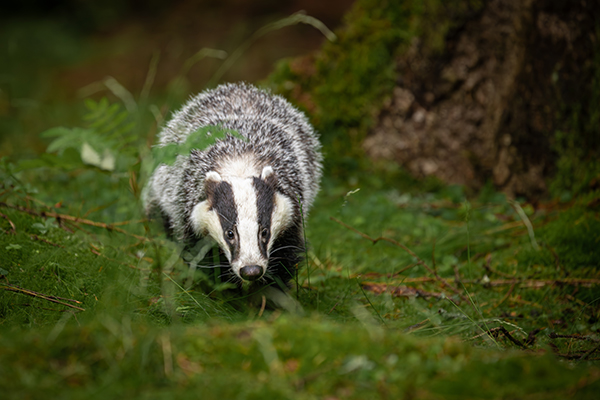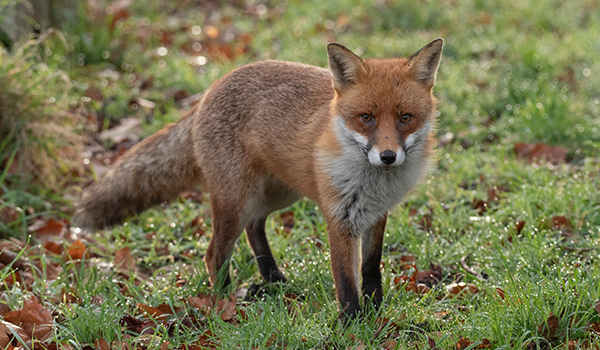Badgers cleared as main culprit of lamb attacks on Scottish farms
Recent research facilitated by the RVC has found that despite farmer perceptions, foxes remain the most likely culprit for lamb attacks in Scottish farms compared to badgers.

Predation, also known as the preying of one animal on another, is a natural part of animal life. However, if it happens on a large scale, it can have a severe impact on farms if livestock are killed or injured during these attacks. As attacks are rarely witnessed by humans, identification of specific prey species can be challenging.
In recent years, there have been growing concerns in the Scottish farming sector about the suspected role badgers play in killing lambs. This was supported by a survey in 2019 indicating that 11 per cent of wildlife attacks on livestock were attributed to badgers, increasing to more than 30 per cent in regions with higher badger density.
However, badgers are a protected species so any mitigation decisions must be based on evidence of both the predator species responsible and the scale of the impact. Therefore, this research, led by Science and Advice for Scottish Agriculture (SASA), in partnership with NatureScot, National Farmers Union Scotland (NFUS) and Scottish Land and Estates (SLE), and supported by the RVC, set out to assess the role of badgers in lamb predation.
Twenty-seven farms across Scotland that suspected they had previously lost lambs to badger predation volunteered to take part in the research. The study used a questionnaire to better understand farmers’ concerns regarding potential badger predation. Post-mortem examinations, led by Henny Martineau, Head of Veterinary Forensic Pathology and Senior Lecturer in Anatomic Pathology at the RVC, and supported by Hasita Dodhia, final year student at the RVC, were also carried out to confirm if predation was the cause of death, or if the lamb had died from another reason and had then been scavenged. DNA analysis was also conducted to identify what species had been in contact with the carcass.
The findings revealed that predation was confirmed in 48 per cent of lambs. Thirty-one per cent were found to be scavenged after death and predation could not be ruled out for the remaining 21 per cent.
Fox DNA was present on 87 per cent of the lambs, including all the lambs that showed evidence of predation. Meanwhile, badger DNA was only detected on 5 per cent of lambs but not on any of the lambs where predation was confirmed.
The results suggest that foxes remain the most likely culprit for lamb predation where it occurs on Scottish farms. This study highlights the value of using post-mortem examination and molecular evidence to accurately confirm predation events and to identify predator species, informing appropriate management interventions moving forward.

Henny Martineau, Head of Veterinary Forensic Pathology and Lecturer in Anatomic Pathology at the RVC, said:
“This research has provided vital evidence to ease concerns that badgers are the main culprit of lamb attacks on Scottish farms. Working as a team with multiple specialists in the field together with good farmer engagement, helped us to interpret our findings quickly and effectively.
“The patterns of injury recorded during post-mortem examination will also serve as a reference for working out what predator species could be responsible for lamb attacks in the future.”
Sheila George, Wildlife Biologist at SASA, said:
“Livestock predation can be distressing for farmers but understanding the species responsible, and field signs to look out for, can inform how livestock managers respond.
“We did not find DNA evidence that badgers killed lambs or regularly scavenged carcasses, but DNA analysis indicated that foxes were responsible where predation occurred. The findings show the importance of taking an evidence-based approach and should help identify appropriate mitigation to reduce future predation risk.”
Notes to Editors
Reference
George, S.C., Campbell, S., Martineau, H., Hale, C., Kaden, J. and Webster, L.M.I. (2024). Are Eurasian badgers responsible for lamb predation? An investigation using farmer interviews, post-mortem examination and molecular tools. Ecological Solutions and Evidence, DOI: 10.1002/2688-8319.12370
The full paper is available here: https://besjournals.onlinelibrary.wiley.com/doi/full/10.1002/2688-8319.12370
For media enquiries, please contact:
- Jasmin De Vivo at jasmin.devivo@plmr.co.uk or rvc@plmr.co.uk
- Press Line: 0800 368 9520
About the RVC
- The Royal Veterinary College (RVC) is the UK's largest and longest established independent veterinary school and is a Member Institution of the University of London.
- It is one of the few veterinary schools in the world that hold accreditations from the RCVS in the UK (with reciprocal recognition from the AVBC for Australasia, the VCI for Ireland and the SAVC for South Africa), the EAEVE in the EU, and the AVMA in the USA and Canada.
- The RVC is ranked as the top veterinary school in the world in the QS World University Rankings by subject, 2024.
- The RVC offers undergraduate and postgraduate programmes in veterinary medicine, veterinary nursing and biological sciences.
- The RVC is a research-led institution, with 88% of its research rated as internationally excellent or world class in the Research Excellence Framework 2021.
- The RVC provides animal owners and the veterinary profession with access to expert veterinary care and advice through its teaching hospitals and first opinion practices in London and Hertfordshire.
